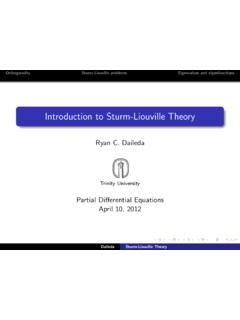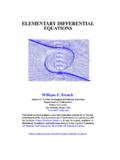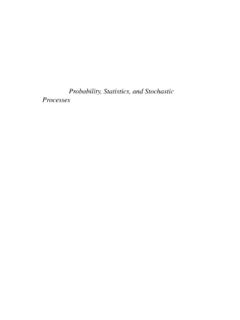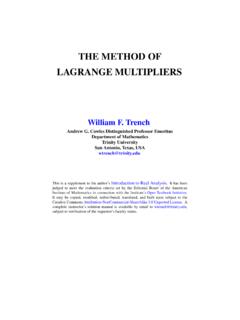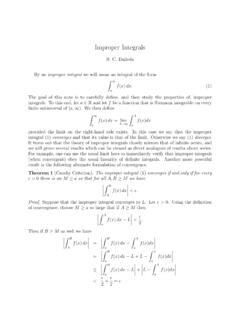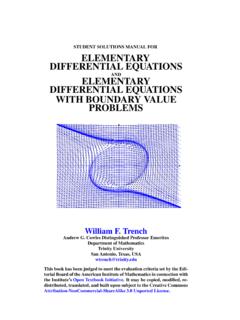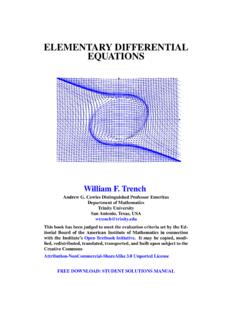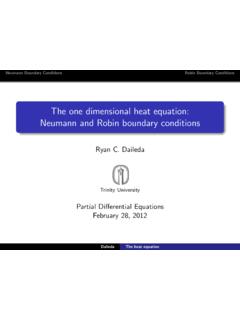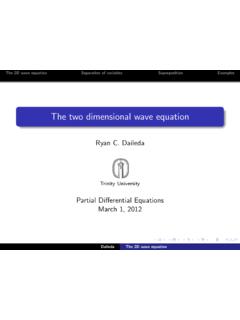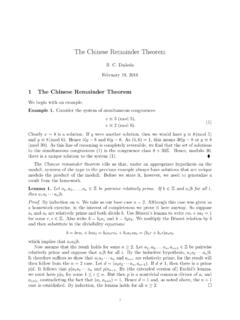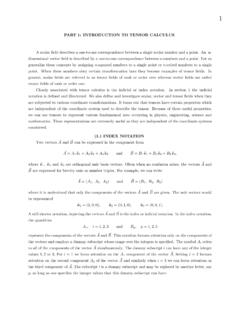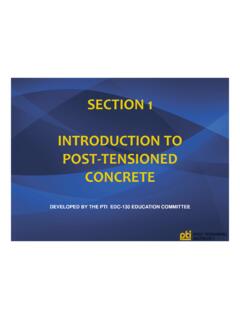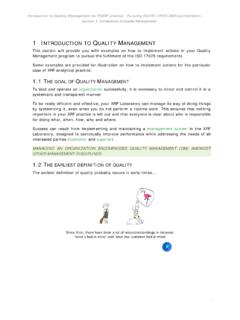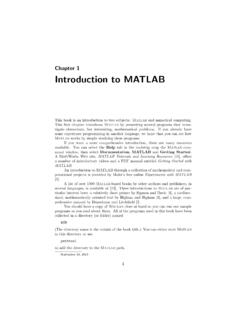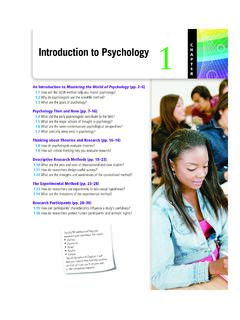Transcription of INTRODUCTION TO REAL ANALYSIS - Trinity University
1 INTRODUCTIONTO real ANALYSISW illiam F. TrenchAndrew G. Cowles Distinguished Professor EmeritusDepartment of MathematicsTrinity UniversitySan Antonio, Texas, book has been judged to meet the evaluation criteria setbythe Editorial Board of the American Institute of Mathematics inconnection with the Institute sOpen Textbook Initiative. It maybe copied, modified, redistributed, translated, and built upon sub-ject to the Creative CommonsAttribution-NonCommercial-ShareAl ike Unported DOWNLOADABLE SUPPLEMENTSFUNCTIONS DEFINED BY IMPROPER INTEGRALSTHE METHOD OF LAGRANGE MULTIPLIERSL ibrary of Congress Cataloging-in-Publication DataTrench, William to real ANALYSIS / William F. Trenchp. 0-13-045786-81. Mathematical ANALYSIS .
2 I. 2003515-dc212002032369 Free Hyperlinked Edition December 2013 This book was published previously by Pearson free edition is made available in the hope that it will beuseful as a textbook or refer-ence. Reproduction is permitted for any valid noncommercial educational, mathematical,or scientific purpose. However, charges for profit beyond reasonable printing costs complete instructor s solution manual is available by email sub-ject to verification of the requestor s faculty status. Although this book is subject to aCreative Commons license, the solutions manual is not. The author reserves all rights tothe BEVERLYC ontentsPrefaceviChapter 1 The real The real Number Mathematical The real Line19 Chapter 2 Differential Calculus of Functions of One Functions and Differentiable Functions of One L Hospital s Taylor s Theorem98 Chapter 3 Integral Calculus of Functions of One Variable Definition of the Existence of the Properties of the Improper A More Advanced Look at the Existenceof the Proper Riemann Integral171 Chapter 4 Infinite Sequences and Sequences of real Earlier Topics Revisited With Infinite Series of Sequences and Series of Power Series257 Chapter 5 real -Valued Functions of Several Structure Continuous real -Valued Function
3 Partial Derivatives and the The Chain Rule and Taylor s Theorem339 Chapter 6 Vector-Valued Functions of Several Variables Linear Transformations and Continuity and Differentiability of The Inverse Function The Implicit Function Theorem417 Chapter 7 Integrals of Functions of Several Definition and Existence of the Multiple Iterated Integrals and Multiple Change of Variables in Multiple Integrals484 Chapter 8 Metric INTRODUCTION to Metric Compact Sets in a Metric Continuous Functions on Metric Spaces543 Answers to Selected Exercises549 Index563 PrefaceThis is a text for a two-term course in introductory real ANALYSIS for junior or senior math-ematics majors and science students with a serious interestin mathematics.
4 Prospectiveeducators or mathematically gifted high school students can also benefit from the mathe-matical maturity that can be gained from an introductory real ANALYSIS book is designed to fill the gaps left in the development ofcalculus as it is usuallypresented in an elementary course, and to provide the background required for insight intomore advanced courses in pure and applied mathematics. The standard elementary calcu-lus sequence is the only specific prerequisite for Chapters 1 5, which deal with real -valuedfunctions. (However, other ANALYSIS oriented courses, such as elementary differential equa-tion, also provide useful preparatory experience.) Chapters 6 and 7 require a workingknowledge of determinants, matrices and linear transformations, typically available from afirst course in linear algebra.
5 Chapter 8 is accessible aftercompletion of Chapters 1 taking a position for or against the current reformsin mathematics teaching, Ithink it is fair to say that the transition from elementary courses such as calculus, linearalgebra, and differential equations to a rigorous real ANALYSIS course is a bigger step to-day than it was just a few years ago. To make this step today s students need more helpthan their predecessors did, and must be coached and encouraged more. Therefore, whilestriving throughout to maintain a high level of rigor, I havetried to write as clearly and in-formally as possible. In this connection I find it useful to address the student in the secondperson. I have included 295 completely worked out examples to illustrate and clarify allmajor theorems and have emphasized careful statements of definitions and theorems and have tried to becomplete and detailed in proofs, except for omissions left to exercises.
6 I give a thoroughtreatment of real -valued functions before considering vector-valued functions. In makingthe transition from one to several variables and from real -valued to vector-valued functions,I have left to the student some proofs that are essentially repetitions of earlier theorems. Ibelieve that working through the details of straightforward generalizations of more elemen-tary results is good practice for the care has gone into the preparation of the 761 numbered exercises, many withmultiple parts. They range from routine to very difficult. Hints are provided for the moredifficult parts of the 1 is concerned with the real number system. section begins with a brief dis-cussion of the axioms for a complete ordered field, but no attempt is made to develop thereals from them; rather, it is assumed that the student is familiar with the consequences ofthese axioms, except for one: completeness.
7 Since the difference between a rigorous andnonrigorous treatment of calculus can be described largelyin terms of the attitude takentoward completeness, I have devoted considerable effort todeveloping its is about induction. Although this may seem out ofplace in a real analysiscourse, I have found that the typical beginning real ANALYSIS student simply cannot do aninduction proof without reviewing the method. section is devoted to elementary set the-ory and the topology of the real line, ending with the Heine-Borel and 2 covers the differential calculus of functions of one variable: limits, continu-ity, differentiablility, L Hospital s rule, and Taylor stheorem. The emphasis is on rigorouspresentation of principles; no attempt is made to develop the properties of specific ele-mentary functions.
8 Even though this may not be done rigorously in most contemporarycalculus courses, I believe that the student s time is better spent on principles rather thanon reestablishing familiar formulas and 3 is to devoted to the Riemann integral of functions of one variable. In Sec-tion the integral is defined in the standard way in terms ofRiemann sums. Upper andlower integrals are also defined there and used in section study the existence of theintegral. section is devoted to properties of the integral. Improper integrals are studiedin section I believe that my treatment of improper integrals is more detailed than inmost comparable textbooks. A more advanced look at the existence of the proper Riemannintegral is given in section , which concludes with Lebesgue s existence criterion.
9 Thissection can be omitted without compromising the student s preparedness for 4 treats sequences and series. Sequences of constant are discussed in Sec-tion I have chosen to make the concepts of limit inferiorand limit superior partsof this development, mainly because this permits greater flexibility and generality, withlittle extra effort, in the study of infinite series. provides a brief introductionto the way in which continuity and differentiability can be studied by means of treat infinite series of constant, sequences and infinite series of functions,and power series, again in greater detail than in most comparable textbooks. The instruc-tor who chooses not to cover these sections completely can omit the less standard topicswithout loss in subsequent 5 is devoted to real -valued functions of several variables.
10 It begins with a dis-cussion of the toplogy ofRnin section Continuity and differentiability are discussedin Sections and The chain rule and Taylor s theorem are discussed in section 6 covers the differential calculus of vector-valued functions of several reviews matrices, determinants, and linear transformations, which are integralparts of the differential calculus as presented here. In section the differential of avector-valued function is defined as a linear transformation, and the chain rule is discussedin terms of composition of such functions. The inverse function theorem is the subject ofSection , where the notion of branches of an inverse is introduced. In section theimplicit function theorem is motivated by first consideringlinear transformations and thenstated and proved in 7 covers the integral calculus of real -valued functions of several variables.
